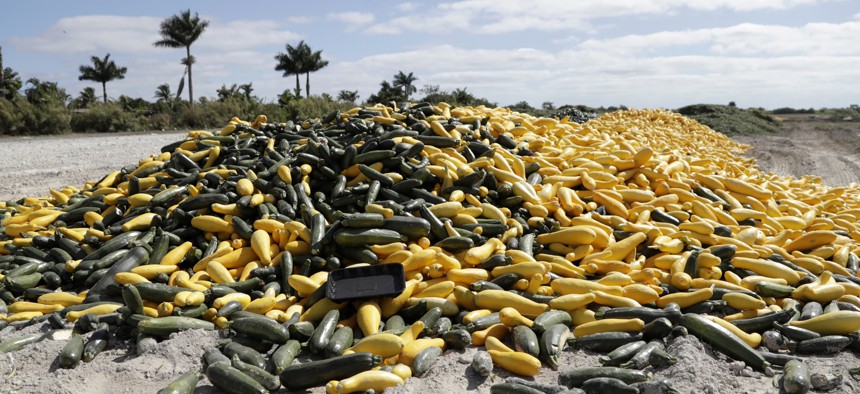States, USDA Launch Programs Help Farmers Sell Excess Produce

In this March 28, 2020, photo, a pile of ripe squash sits in a field, in Homestead, Fla. Thousands of acres of fruits and vegetables grown in Florida are being plowed over or left to rot because farmers can't sell them. AP Photo/Lynne Sladky
With restaurants and schools closed, farmers lost their traditional markets for fresh produce. New state and federal programs hope to connect excess supply with the demand, including at food pantries across the country.
A secondary dilemma of the coronavirus era is the difficulty of connecting farmers, who have lost traditional produce markets and turned to dumping excess milk and destroying vegetables, with the food pantries seeing increased need from millions of Americans forced out of work.
The U.S. Department of Agriculture in recent weeks announced plans to spend $3 billion to purchase fresh produce, dairy and meat directly from farmers and deliver it to food banks, with the first shipments expected to go out close to the end of May. The Farmers to Families Food Box program will procure $300 million worth of produce, meat and dairy each month that distributors and wholesalers will be able to distribute to food banks, schools, and faith-based organizations.
“America’s farmers and ranchers have experienced a dislocated supply chain caused by the Coronavirus,” said Agriculture Secretary Sonny Perdue this week, announcing another $470 million round of commodities purchases. “USDA is in the unique position to purchase these foods and deliver them to the hungry Americans who need it most.”
The move by USDA comes after criticism the agency has acted too slowly, leaving states to launch their own initiatives to try to connect potential buyers with local farmers.
The closure of schools and restaurants to prevent spread of the coronavirus has disconnected farmers from their usual food supply chains, as many sell directly to institutions like schools or restaurant suppliers. At the same time, food banks are dealing with unprecedented demand and finding that their usual sources of donations, such as grocery stores offloading food about to expire, aren’t coming through.
Last month, the Florida Department of Agriculture and Consumer Services launched its own web portal to give interested buyers a way to search daily for available products at farms, which range from seasonal fruit like oranges and blueberries to alligator meat. The website also features a U-pick farm locator, that allows consumers to find open farms where they can pick their own produce.
Agriculture Commissioner Nikki Fried said the initiative would help consumers and the state’s agriculture community. In Florida, mid-April crop losses were estimated to hit $522 million.
Fried has expressed frustration that the USDA’s efforts to buy from farmers “were too late for Florida farmers” who were already harvesting crops when businesses like restaurants closed and orders dried up.
“While we had hoped to see these purchases earlier in the season to allow more Florida farmers to benefit, we’re hopeful this opportunity can mitigate some losses for our producers, ensure food banks can meet demand, and help families access fresh nutrition to stay healthy,” she said last month.
Elsewhere, farmers have organized their own food giveaways to ensure their harvests go to good use rather than rot. Farmers in Moses Lake, Washington distributed nearly 60,000 pounds of potatoes last week to residents during a drive-thru giveaway held in the parking lot of the local fairgrounds.
Across the country, the long lines of people waiting to pick up supplies at food pantries underscore the need for help.
Feeding America, a national network of food relief organizations, reported that 98% of food banks saw an increase in demand for assistance at the beginning of April. But at the same time, 59% said they have reduced inventory and 37% noted an “immediate critical funding shortfall.”
To better connect farmers with buyers, Georgia’s Department of Agriculture is making it easier for farmers to join a state-run membership that promotes local agribusiness. The Georgia Grown program is waiving all membership fees for qualifying businesses through July.
“We are getting a lot of interest from many types of buyers, including consumer, wholesale, food banks and some restaurants,” said Matthew Kulinski, the program’s deputy marketing director. “This is a good way for producers who normally sell to restaurants to have a new outlet for their produce.”
Farmers in the program sell products ranging from vegetables, fruits, seafood, meat, dairy and honey. To join the program, they must keep regular hours, provide curbside pickup, home delivery or online sales during the coronavirus pandemic.
Andrea Noble is a staff correspondent with Route Fifty.





